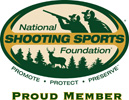GunLink Giveaway: FREE 6-Month Subscription to Firearms Guide Online!
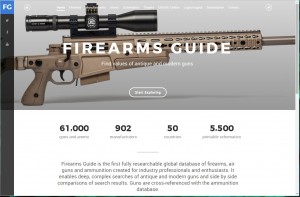 As we have previously told our readers about, firearm mega-reference Firearms Guide made the jump from a DVD-based guide to an online cloud-based firearms reference guide with cross-platform compatibility. Already since then, the Firearms Guide has been making good on their promise to provide more frequent updates to the guide.
As we have previously told our readers about, firearm mega-reference Firearms Guide made the jump from a DVD-based guide to an online cloud-based firearms reference guide with cross-platform compatibility. Already since then, the Firearms Guide has been making good on their promise to provide more frequent updates to the guide.
The Firearms Guide Online is a great reference that offers high-res photos, specifications, and blow-up diagrams of tens of thousands of firearms and we want to help share the guide with by giving out some FREE 6-Month Subscriptions to Firearms Guide Online!
Use the widget above to enter in a variety of ways:
- One entry for following @GunLink on Twitter
- One entry for following @FirearmsGuide on Twitter
- One entry for Visit & Like GunLink on Facebook
- One entry for commenting on this post about why you want the prize
- One entry per day for tweeting giveaway message
- Five entries for posting in the giveaway forum thread
We will give away two subscriptions this time around, with more to come shortly. Stay tuned!
ATF Publishes Open Letter Law Enforcement on 41F Policies
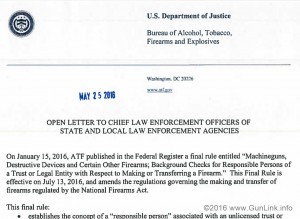 The BATFE recently published an open letter to Chief Law Enforcement Officers (CLEOs) regarding the January 41F ruling (fmr 41P) which makes changes to the way in which NFA applications are handled for legal entities and individuals.
The BATFE recently published an open letter to Chief Law Enforcement Officers (CLEOs) regarding the January 41F ruling (fmr 41P) which makes changes to the way in which NFA applications are handled for legal entities and individuals.
In part, the letter specifies “that a copy of all applications to make or transfer a firearm, and the responsible person questionnaire, if applicable, be forwarded to the [CLEO] of the locality in which the applicant, transferee or responsible person is located (“CLEO notification”)” and that the ruling “eliminates the requirement that an applicant obtain a certification signed by the CLEO before the transfer or making of an NFA firearm may be approved.“
The letter goes on to explain that there is no action required by the CLEO upon receipt (or lack thereof) of the paperwork – to include even confirming receipt of the documents. Further, the letter says that it is up to each CLEO to determine how they dispose of or retain (and whether or not they do either).
Of immediate concern are several potential issues regarding this lackadaisical hands-off approach to record keeping and privacy mandates. One concern would be with how an applicant would prove that they met the new CLEO notification requirement if there is no acknowledgment of receipt by the CLEO, and what future repercussions might be. Application denials? Revocation of approved applications with forced surrender of the firearms? The ATF has already proven that they are not above such tactics in the recent Form 1 Machine Gun debacles, which are still in litigation. Or worse?
The second concern would be how the CLEOs are protecting applicants sensitive information that is contained in the notification paperwork. As the $200 cost associated with making or transferring NFA firearms ($5 for transferring AOWs) is not a fee or a price for goods or services sold but, rather, the tax paid for making or transferring the item, the application could well be considered a tax document. This document details the what firearms are being made or transferred, at which physical address, and – for many applicants – their home address, photograph, fingerprints, signature, and other sensitive information. This information could potentially be problematic if it fell into the wrong hands, which is not outside the realm of possibilities when the CLEO is able to simply toss your notification paperwork into the trash bin for dumpster divers to find or leave it laying around on a desk at the PD for petty crooks to have a look at as they are brought through.
As if identity theft wasn’t enough of an issue, without any mandated safeguards on how this information is to be protected, consider the possibility of a motivated criminal coming to Joe Gunguy’s house at 123 Anystreet Lane to steal the expensive 7.5″ Noveske 5.56 AR-15 pattern rifle to use on the streets. If this firearm is so much more dangerous than an off-the-shelf firearm that it requires owners to to register them and pay an extra $200 tax on them and notify the government when we travel with them, does it make sense for the CLEOs to treat the information about those weapons so recklessly? Or is this just another spotlight on the absurdity of the NFA in general?
The full text of the letter is here. Further discussion of the open letter to CLEOs is available on Joshua Prince’s law blog.
The Ins and Outs of Shipping Firearms
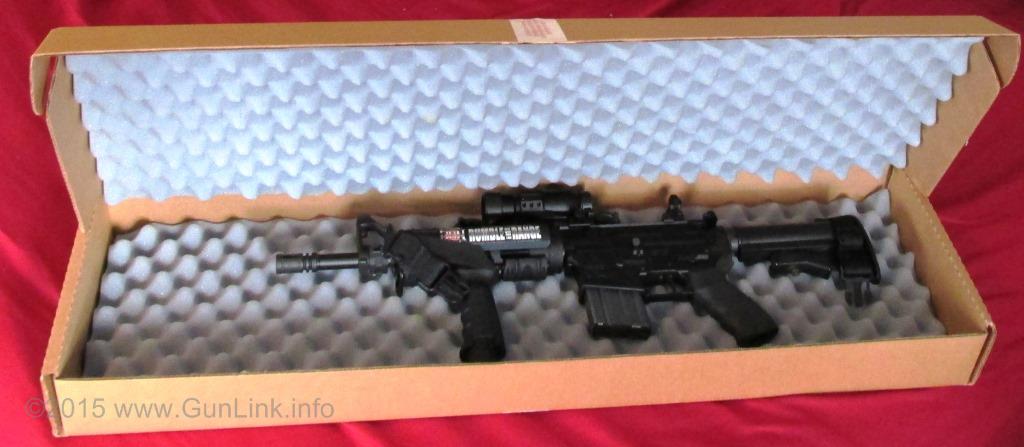 Shipping a firearm can be a confusing ordeal and the plethora of conflicting information and anecdotes floating around online and at gun counters doesn’t make the matter any clearer. Is it illegal to ship a firearm with a particular carrier? Is it against this carrier’s company policies? What about the USPS? Can it go across state lines? Does it matter who I ship it to? Can I ship it to myself instead of flying with a firearm?
Shipping a firearm can be a confusing ordeal and the plethora of conflicting information and anecdotes floating around online and at gun counters doesn’t make the matter any clearer. Is it illegal to ship a firearm with a particular carrier? Is it against this carrier’s company policies? What about the USPS? Can it go across state lines? Does it matter who I ship it to? Can I ship it to myself instead of flying with a firearm?
First off, the rules are different for licensees (FFL holders) versus non-licensees. We are mainly going to cover the rules for the non-licensed average Joe here since, if you are an FFL you probably already know how to ship firearms. We will briefly touch on some aspects of FFL shipping, however, since having a licensee do your shipping can often be easier and more affordable than doing it on your own.
If you ship incorrectly, you may end up facing consequences like denied insurance claims if your firearm is lost or damaged or, worse, going to jail. With these kind of high stakes, it pays to do it right at all levels when shipping a firearm. Continue reading
GunLink Visits the Home of Black Nitride, AR Components
Checking Out the Operations at H&M and Rubber City Armory
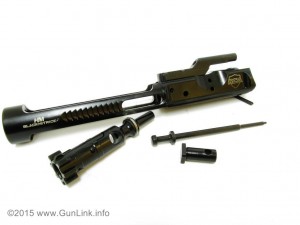 If you have been keeping up with our weekly posts about what’s new at Brownells, you may remember a recent one in which Paul Levy told us about the low mass AR-15 bolt carrier group from Rubber City Armory (RCA). This caught my attention since Rubber City is the nickname of a certain Ohio city from whence one of the GunLink team members originally came and it just so happens that we get back there to visit every so often.
If you have been keeping up with our weekly posts about what’s new at Brownells, you may remember a recent one in which Paul Levy told us about the low mass AR-15 bolt carrier group from Rubber City Armory (RCA). This caught my attention since Rubber City is the nickname of a certain Ohio city from whence one of the GunLink team members originally came and it just so happens that we get back there to visit every so often.
I reached out to RCA and who else is on the other end than Chris Cerino himself – 2nd place finisher on History Channel’s Top Shot Season 1 and Top Shot All Stars, Gun Talk TV field host, and firearms instructor. Add to that list Director of Operations for Rubber City Armory, a subsidiary of H&M Metal Processing – the home of Black Nitride™. After exchanging a few communiques, we arranged to stop by and check out their operation on an upcoming trip to the area.
The GunLink team arrived on the day of our visit and, wouldn’t you know it, Chris had bailed. Can you believe the nerve of this guy? Only kidding – Chris was attending to the higher priority of kicking ass and taking names at the Blue Ridge Mountain 3-Gun Championship. Despite the lack of television personalities accompanying us, our awesome hosts Shade and Pete gave us the grand tour and showed us around both the H&M and RCA sides of the equation. Continue reading
Flying with Firearms – The (RKBA) Friendly Skies
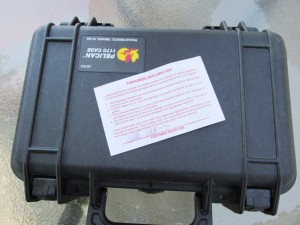 A conversation that I had with one of the vendors at the recent NRAAM in Nashville got me thinking about traveling with firearms. Although certainly not a member of the jet set, I do a fair amount of traveling for work and pleasure – much of it on commercial airlines – and I often take a firearm with me. Whether it is for business, family vacation, a relaxing getaway, a big hunt, or something else, plenty of people find themselves flying around the US. Last year alone, scheduled commercial flights carried nearly 663 million domestic passengers.
A conversation that I had with one of the vendors at the recent NRAAM in Nashville got me thinking about traveling with firearms. Although certainly not a member of the jet set, I do a fair amount of traveling for work and pleasure – much of it on commercial airlines – and I often take a firearm with me. Whether it is for business, family vacation, a relaxing getaway, a big hunt, or something else, plenty of people find themselves flying around the US. Last year alone, scheduled commercial flights carried nearly 663 million domestic passengers.
One can’t help but figure that it is a safe bet that some of those flyers were CCW-ers, hunters, or otherwise among the many millions of firearm owners in the US – and many of them probably took their firearms with them. So… how do they do it?
Read on to find out Continue reading
Yes, YOU can Own NFA Items Like Silencers, SBRs and Machine Guns
And it’s Probably Easier than you Think
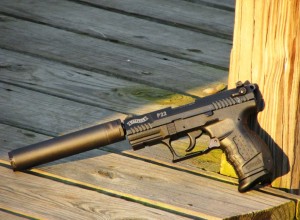 I was shooting a suppressed pistol at the range this week when I heard the whispers from a few lanes down. Incidentally, one of the benefits of shooting suppressed weapons is that you not only retain the ability to hear whispers but you can hear them while you are shooting. “Why is that gun so quiet? A suppressor? Are those even legal to own?“
I was shooting a suppressed pistol at the range this week when I heard the whispers from a few lanes down. Incidentally, one of the benefits of shooting suppressed weapons is that you not only retain the ability to hear whispers but you can hear them while you are shooting. “Why is that gun so quiet? A suppressor? Are those even legal to own?“
It’s a common enough question, and the answer is Yes. Well – a qualified “yes.” Per the map at SilencerCo’s www.SilencersAreLegal.com site, private civilian ownership of suppressors is currently allowed in 39 states. After shedding some light on how the process works and letting the whisperers run a few rounds through the suppressed .22, they seemed excited and were asking more questions, including ones about how to get started and how much it costs.
The ownership of suppressors (a/k/a silencers), along with other National Firearms Act (NFA) regulated items such as short-barreled rifles (SBR) and short-barreled shotguns (SBS), destructive devices, and, yes, even machine guns, is the subject of a lot of rumors, myths, and misinformation. Although heavily regulated by federal law, provided that you live in a state where their ownership is not prohibited, ownership of these items is perfectly legal.
Common Myths
Some of the more prevalent myths include that they are unequivocally illegal to own (they aren’t), you need a license to buy NFA items (you don’t), that the ATF can come barging in to look at your firearms whenever they feel like it (they can’t), nobody else can enjoy your NFA items even with you present (they can), and that playing the NFA game is expensive. Continue reading







